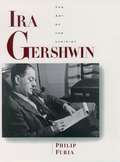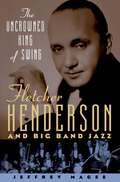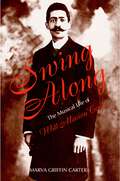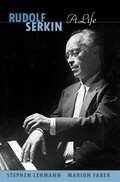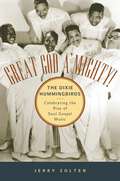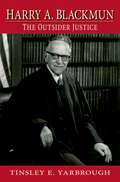- Table View
- List View
Twenty Wagging Tales: Our Year of Rehoming Orphaned Dogs
by Barrie HawkinsAfter losing his beloved dog, Elsa, Barry can't face replacing her. When he accepts a rescue worker's proposal to become a dog foster parent he doesn’t realise what he is letting himself in for. This heart-warming collection of true furry tales follows the highs and lows of Barrie and his wife as they take on the challenge of rescuing dogs.
Portrait Of A Marriage: Vita Sackville-West and Harold Nicolson
by Vita Sackville-West Nigel Nicolson MBEThe fascinating story of an unconventional, bisexual and powerfully loving relationship and a unique portrait of gender and feminism - with a new introduction from Juliet Nicolson.'A brilliantly structured account of the dramas, infidelities and deep emotional attachments' GUARDIAN'An intimate and controversial account of his bisexual parents' open relationship' NEW YORK TIMES'One of the most absorbing stories, built around two very remarkable people, ever to stray from Gothic fiction into real life' TLSThe marriage was that between the two writers, Vita Sackville-West and Harold Nicolson and the portrait is drawn partly by Vita herself in an autobiography which she left behind at her death in 1962 and partly by her son, Nigel. It was one of the happiest and strangest marriages there has ever been. Both Vita and Harold were always in love with other people and each gave the other full liberty 'without enquiry or reproach', knowing that their love for each other would be unaffected and even strengthened by the crises which it survived. This account of their love story is now a modern classic.
No Fixed Abode: A Journey Through Homelessness from Cornwall to London
by Charlie CarrollCharlie’s teaching contract came to an end and he found himself with no job and no money, but all the time in the world. He decided to travel from Cornwall to London in remarkably cheap way – as a tramp, on foot. With a mix of travel and current affairs writing, No Fixed Abode sheds light on a side of the UK few ever see from within.
American Football für Dummies (Für Dummies)
by John Czarnecki Howie LongSo geht Football American Football für Dummies ist ein umfassender Leitfaden für Fans des Footballs. In diesem Buch erfahren Sie das Wichtigste zu Aufstellung, Regeln und Strategien. Die Football-Legende Howie Long und der Football-Analyst John Czarnecki präsentieren mit ausführlichen Erklärungen zu jeder Position, Analysen von Angriff und Verteidigung und detaillierten Spielstrategien die Grundlagen des Footballs für Fans jeden Alters und jeder Erfahrung. Verschaffen Sie sich das Wissen, das Sie brauchen, um dem Footballspiel zu folgen und es mit Freunden und Familie zu genießen. Sie erfahren Was es über das Spielfeld und die Ausrüstung zu wissen gibt Welche Offense-Strategien und Defense-Taktiken es gibt Was es mit den Special Teams auf sich hat Wie die Secondary funktioniert
A Thousand Miles From Care: The Hunt for My Brother’s Killer – A Thirty-Year Quest for Justice
by null Steve JohnsonSoon to be a MAJOR MOVIE. A gripping and heartbreaking story, A Thousand Miles from Care tells the 30-year quest Steve Johnson undertook to uncover the truth about his brilliant brother’s death. At the entrance of Sydney Harbor, the cliffs rise fourteen stories above the Pacific, like a gigantic skirt made of sandstone. North Head, one of the most memorable cliffs, is a gorgeous place to watch the sunrise. But it’s an unforgiving place to lose your footing. When Steve Johnson’s younger brother Scott went over the edge in 1988, he hit an outcrop on the way down and exploded on the rocks below. A Thousand Miles from Care draws upon the mountain of exclusive materials Steve amassed over his 32-year fight for answers, including sealed court transcripts, police records, interviews with suspects, inquest reports, correspondence with gang members, private investigations, and much else. It utilizes unique details, interview transcripts and insights based on Johnson’s close relationship with authorities and high-ranking New South Wales officials developed over more than three decades. This profoundly impactful book traces the steps Steve Johnson, his family and friends took to solve the mystery of Scott’s alleged suicide, navigating an openly hostile police force and a maze of dead ends, unreliable informants, skinhead gangs, a faked confession, police-connected drug rings, and setbacks at every turn. A Thousand Miles from Care is above all, a love story between two brothers but shared by everyone who worked so long for truth and justice for Scott.
Mevlevi Manuscripts, 1268–c. 1400: A Study of the Sources
by Cailah JacksonThis book provides a detailed and carefully researched catalogue of over 140 manuscripts related to the Mevlevi Sufis in their formative period during the thirteenth and fourteenth centuries. It also offers an in-depth and rigorous analysis of the manuscript material, which reveals much about the role of manuscripts in early Mevlevi life, the identity of disciples who were scribes and manuscript owners, and the geographical spread of the Sufi group. The Mevlevi Sufis were one of the most important and prominent socio-religious groups to emerge in late medieval Anatolia, following the Mongol conquests of the 1240s. Sometimes known colloquially as the ‘whirling dervishes,’ the Mevlevis became particularly powerful under Ottoman rule in the early modern period, even counting some sultans as their disciples. However, there is still much to learn about their earliest days, following the death of their ‘patron saint’ Jalal al-Din Rumi in 1273. Rumi is of course also notable as the authorof the Masnavi, an extensive work of Sufi poetry written in rhyming couplets that is the core of Mevlevi ritual and learning. Beyond Mevlevi circles, Rumi remains very popular today as a ‘mystic’ poet. This study sheds new light on the intellectual culture of his time.
The Life of Charlotte Bront? (Oxford World's Classics)
by Elizabeth Gaskell'It is in every way worthy of what one great woman should have written of another.' Patrick Bront? Elizabeth Gaskell's The Life of Charlotte Bront? (1857) is a pioneering biography of one great Victorian woman novelist by another. Gaskell was a friend of Charlotte Bront?, and, having been invited to write the offical life, determined both to tell the truth and to honour her friend. She contacted those who had known Charlotte and travelled extensively in England and Belgium to gather material. She wrote from a vivid accumulation of letters, interviews, and observation, establishing the details of Charlotte's life and recreating her background. Through an often difficult and demanding process, Gaskell created a vital sense of a life hidden from the world. This edition is based on the Third Edition of 1857, revised by Gaskell. It has been collated with the manuscript, and the previous two editions, as well as with Charlotte Bront?'e's letters, and thus offers fuller information about the process of composition than any previous edition. ABOUT THE SERIES: For over 100 years Oxford World's Classics has made available the widest range of literature from around the globe. Each affordable volume reflects Oxford's commitment to scholarship, providing the most accurate text plus a wealth of other valuable features, including expert introductions by leading authorities, helpful notes to clarify the text, up-to-date bibliographies for further study, and much more.
Ira Gershwin: The Art of the Lyricist
by Philip FuriaTo the perennial question "which comes first, the music or the words?" Ira Gershwin always responded, "the contract." The jest reveals both Ira's consummate professionalism and the self-effacing wit with which he ducked the spotlight whenever possible. Yet the ingeniously inventive melodies George Gershwin composed for such classic songs as "Someone to Watch Over Me," "Embraceable You," "Fascinating Rhythm," "It Ain't Necessarily So," and "Love is Here to Stay" live on in no small part because of the equally unforgettable lyrics of Ira Gershwin, lines crafted with a precision that earned him the sobriquet "The Jeweller" among his Broadway peers. In Ira Gershwin: The Art of the Lyricist, the older and less flamboyant of the Gershwin brothers at last steps out of the shadows to claim his due as one of American songwriting's most important and enduring innovators. Philip Furia traces the development of Ira Gershwin's lyrical art from his early love of light verse and Gilbert and Sullivan, through his apprentice work in Tin Pan Alley, to his emergence as a prominent writer for the Broadway musical theater in the 1920s. Furia illuminates his work in satirical operettas such as Of Thee I Sing and Strike Up the Band, the smart "little" revues of the 1930s, and his contributions to the opera Porgy and Bess. After describing the Gershwin brothers' brief but brilliant work in Hollywood before George's sudden death--work that produced such classics as "They Can't Take That Away From Me" and "Let's Call the Whole Thing Off"--Furia follows Ira's career through such triumphs as Lady in the Dark with Kurt Weill, Cover Girl with Jerome Kern, and A Star is Born, with Harold Arlen. Along the way, Furia provides much insight into the art of the lyricist and he captures the magic of a golden era when not only the Gershwins, but Irving Berlin, Cole Porter, Jerome Kern, Oscar Hammerstein II, Gertrude Lawrence, Fred Astaire, and other luminaries made the lights of Broadway and the Hollywood screen shine brighter than ever before. From his first major success, the now-classic "The Man I Love" (1924) to his last great hit, "The Man That Got Away" (1954), Ira Gershwin wrote the words to some of America's most loved standards. In Ira Gershwin: The Art of the Lyricist, Philip Furia illuminates the craft behind this remarkable achievement to reveal how Gershwin took the everyday speech of ordinary Americans and made it sing.
The Uncrowned King of Swing: Fletcher Henderson and Big Band Jazz
by Jeffrey MageeIf Benny Goodman was the "King of Swing," then Fletcher Henderson was the power behind the throne. Now Jeffrey Magee offers a fascinating account of Henderson's musical career, throwing new light on the emergence of modern jazz and the world that created it. Drawing on an unprecedented combination of sources, including sound recordings and hundreds of scores that have been available only since Goodman's death, Magee illuminates Henderson's musical output, from his early work as a New York bandleader, to his pivotal role in building the Kingdom of Swing. He shows how Henderson, standing at the forefront of the New York jazz scene during the 1920s and '30s, assembled the era's best musicians, simultaneously preserving jazz's distinctiveness and performing popular dance music that reached a wide audience. Magee reveals how, in Henderson's largely segregated musical world, black and white musicians worked together to establish jazz, how Henderson's style rose out of collaborations with many key players, how these players deftly combined improvised and written music, and how their work negotiated artistic and commercial impulses. Whether placing Henderson's life in the context of the Harlem Renaissance or describing how the savvy use of network radio made the Henderson-Goodman style a national standard, Jeffrey Magee brings to life a monumental musician who helped to shape an era. "An invaluable survey of Henderson's life and music." --Don Heckman, Los Angeles Times "Magee has written an important book, illuminating an era too often reduced to its most familiar names. Goodman might have been the King of Swing, but Henderson here emerges as that kingdom's chief architect." --Boston Globe "Excellent.... Jazz fans have waited 30 years for a trained musicologist...to evaluate Henderson's strengths and weaknesses and attempt to place him in the history of American music." --Will Friedwald, New York Sun
Swing Along: The Musical Life of Will Marion Cook
by Marva CarterRenowned today as a prominent African-American in Music Theater and the Arts community, composer, conductor, and violinist Will Marion Cook was a key figure in the development of American music from the 1890s to the 1920s. In this insightful biography, Marva Griffin Carter offers the first definitive look at this pivotal life's story, drawing on both Cook's unfinished autobiography and his wife Abbie's memoir. A violin virtuoso, Cook studied at Oberlin College (his parents' alma mater), Berlin's Hochschule f?r Musik with Joseph Joachim, and New York's national Conservatory of Music with Antonin Dvorak. Cook wrote music for a now-lost production of Uncle Tom's Cabin for the Chicago World's Fair of 1893, and then devoted the majority of his career to black musical comedies due to limited opportunities available to him as a black composer. He was instrumental in showcasing his Southern Syncopated Orchestra in the prominent concert halls of the Unites States and Europe, even featuring New Orleans clarinetist Sidney Bechet, who later introduced European audiences to authentic blues. Once mentored by Frederick Douglas, Will Marion Cook went on to mentor Duke Ellington, paving the path for orchestral concert jazz. Through interpretive and musical analyses, Carter traces Cook's successful evolution from minstrelsy to musical theater. Written with his collaborator, the distinguished poet Paul Lawrence Dunbar, Cook's musicals infused American Musical Theater with African-American music, consequently altering the direction of American popular music. Cook's In Dahomey, hailed by Gerald Bordman as "one of the most important events in American Musical Theater history," was the first full-length Broadway musical to be written and performed by blacks. Alongside his accomplishments, Carter reveals Cook's contentious side- a man known for his aggressiveness, pride, and constant quarrels, who became his own worst enemy in regards to his career. Carter further sets Cook's life against the backdrop of the changing cultural and social milieu: the black theatrical tradition, white audiences' reaction to black performers, and the growing consciousness and sophistication of blacks in the arts, especially music.
The Letters of Hildegard of Bingen: Volume III
by Hildegard of BingenThis is the third and final volume of the complete annotated correspondence of the extraordinary nun, Hildegard of Bingen (1098-1179). One of the most remarkable women of her day, Hildegard was, for more than 30 years, an unflinching advisor and correspondent of all levels of church and society, from popes and kings to ordinary lay persons, from Jerusalem to England. This present volume (letters 218-390) is noteworthy for its large collection of letters to a non-ecclesiastical audience, and because it contains letters not just to such high-ranking notables as Frederick Barbarossa, King Henry II of England, or Eleanor or Acquitaine, but also to common, ordinary individuals of no importance whatsoever, save that they received a letter from Hildegard of Bingen. Addressing matters as diverse as the "humors" and their relation to health and salvation, the fate of departed souls, the frequency and horror of homicide in her age, a means of exorcising malignant spirits, an effective kind of incantation to alleviate nightmares, the proper attitude and response to the fact of excommunication, and male infidelity in marriage, Hildegard provides a unique view of the twelfth century world. Here also are found compositions in epistolary style that are actually sermons, mediations, prayers, or treatises on a wide range of theological topics, such as prophecy, celebration of the Mass, the Lord's Prayer, the creation, and the fall of Adam. Like previous volumes, the translation follows the most recent definitive Latin text, in which the letters are organized according to the rank and station of Hildegard's correspondents.
Rudolf Serkin: A Life
by Marion Faber Stephen LehmannThis book is the first biography of 20th-century pianist Rudolf Serkin, providing a narrative of Serkin's life with emphasis on his European roots and the impact of his move to America. Based on his personal papers and correspondence, as well as extensive interviews with friends, family, and colleagues, the authors focus on three key aspects of Serkin's work, particularly as it unfolded in America: his art and career as a pianist, his activities as a pedagogue, including his long association with the Curtis Institute in Philadelphia, and his key role in institutionalizing a redefinition of musical values in America through his work as artistic director of the Marlboro Music School and Festival in Vermont. A candid and colorful blend of narrative and interviews, it offers a probing look into the life and character of this very private man and powerful musical personality.
Great God A'Mighty! The Dixie Hummingbirds: Celebrating the Rise of Soul Gospel Music
by Jerry ZoltenFrom the Jim Crow world of 1920s Greenville, South Carolina, to Greenwich Village's Caf? Society in the '40s, to their 1974 Grammy-winning collaboration on "Loves Me Like a Rock," the Dixie Hummingbirds have been one of gospel's most durable and inspiring groups. Now, Jerry Zolten tells the Hummingbirds' fascinating story and with it the story of a changing music industry and a changing nation. When James Davis and his high-school friends starting singing together in a rural South Carolina church they could not have foreseen the road that was about to unfold before them. They began a ten-year jaunt of "wildcatting," traveling from town to town, working local radio stations, schools, and churches, struggling to make a name for themselves. By 1939 the a cappella singers were recording their four-part harmony spirituals on the prestigious Decca label. By 1942 they had moved north to Philadelphia and then New York where, backed by Lester Young's band, they regularly brought the house down at the city's first integrated nightclub, Caf? Society. From there the group rode a wave of popularity that would propel them to nation-wide tours, major record contracts, collaborations with Stevie Wonder and Paul Simon, and a career still vibrant today as they approach their seventy-fifth anniversary. Drawing generously on interviews with Hank Ballard, Otis Williams, and other artists who worked with the Hummingbirds, as well as with members James Davis, Ira Tucker, Howard Carroll, and many others, The Dixie Hummingbirds brings vividly to life the growth of a gospel group and of gospel music itself.
Self-Portrait of Percy Grainger
by Malcolm Gillies, David Pear, and Mark CarrollShortly before his death, Percy Grainger (1882-1961) lodged over twenty unpublished sketches in his Australian Museum. Self-Portrait of Percy Grainger draws exclusively from these sketches, revealing for the first time an illuminating portrait of the composer's life. With such titles as "The Aldridge-Grainger-Strom Saga," "Thunks," "Ere-I-Forget," "The Love-Life of Helen and Paris," and "Anecdotes," these manuscripts were intended as precursors to Grainger's autobiography, My Wretched Tone-Life, which he only commenced in his final years. Expertly shaping these sketches, the editors have created a "self-portrait" along the lines that Grainger himself had intended. The volume first introduces Grainger's forebears, parents, friends, wife, and himself before moving on to his views on composition, performance, and the musical world. In these sketches, Grainger addresses such topics as racial and national identity, the meaning of work, physical culture, language reform, sexual practice, and artistic patronage. Grainger also probes the nature of musical genius, discussing a broad range of composers including Igor Stravinsky, Thomas Beecham, Frederick Delius, Edvard Grieg, Charles Stanford, Cyril Scott, Fritz Kreisler, Donald Tovey, Ferruccio Busoni, and Balfour Gardiner. Among the works of his own that Grainger most featured are his The Warriors --Music for an Imaginary Ballet, Colonial Song, the Lincolnshire Posy series of band pieces, his greatest "hit" Country Gardens, and his many settings of English folk-music. Written in Grainger's own self-created "Nordic English" as well as translated from Danish, the language of his most intimate confessions, Self-Portrait of Percy Grainger sheds light on some of the most revealing details of the composer's life. The sketches trace Grainger's changing self-perception, from the romantically tinged, even lustful, views of his forties and fifties, through a period of wistfulness in his sixties, to the bitterness and self-loathing of his old age. The volume also includes several of Grainger's own drawings as well as both public and private photographs. A fascinating and revealing collection of vignettes, this extraordinary book will appeal to instructors, students, and enthusiasts in musicology, music history, cultural studies, and Australian, British, and American history.
Harry A. Blackmun: The Outsider Justice
by Tinsley YarbroughWhen appointed to the Supreme Court in 1970 by President Nixon, Harry A. Blackmun was seen as a quiet, safe choice to complement the increasingly conservative Court of his boyhood friend, Warren Burger. No one anticipated his seminal opinion championing abortion rights in Roe v. Wade, the most controversial ruling of his generation, which became the battle cry of both supporters and critics of judicial power and made Blackmun a liberal icon. Harry A. Blackmun: The Outsider Justice is Tinsley E. Yarbrough's penetrating account of one of the most outspoken and complicated figures on the Supreme Court. As a justice, Blackmun stood at the pinnacle of the American judiciary. Yet when he took his seat on the Court, Justice Blackmun felt "almost desperate," overwhelmed with feelings of self-doubt and inadequacy over the immense responsibilities before him. Blackmun had overcome humble roots to achieve a Harvard education, success as a Minneapolis lawyer and resident counsel to the prestigious Mayo Clinic, as well as a distinguished record on the Eighth Circuit federal appeals court. But growing up in a financially unstable home with a frequently unemployed father and an emotionally fragile mother left a permanent mark on the future justice. All his life, Harry Blackmun considered himself one of society's outsiders, someone who did not "belong." Remarkably, though, that very self-image instilled in the justice, throughout his career, a deep empathy for society's most vulnerable outsiders--women faced with unwanted pregnancies, homosexuals subjected to archaic laws, and ultimately, death-row inmates. To those who saw his career as the constitutional odyssey of a conservative jurist gradually transformed into a champion of the underdog, Blackmun had a ready answer: he had not changed; the Court and the issues before them changed. The justice's identification with the marginalized members of society arguably provides the overarching key to that consistency. Thoroughly researched, engagingly written, Harry A. Blackmun: The Outsider Justice offers an in-depth, revelatory portrait of one of the most intriguing jurists ever to sit on the Supreme Court. Relying on in-depth archival material, in addition to numerous interviews with Blackmun's former clerks, Yarbrough here presents the definitive biography of the great justice, ultimately providing an illuminating window into the inner-workings of the modern Supreme Court.







